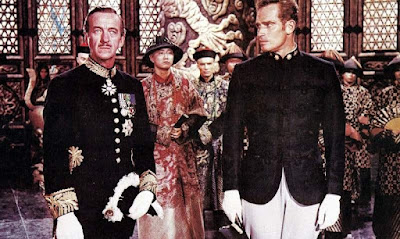I don’t know how exactly to describe Fellini Satyricon. It’s a visually stunning film that amazes a viewer with its unusual style, but it’s also very narratively confusing, given its episodic nature of storytelling. It’s enigmatic almost to the point at times of being impenetrable because of its very fragmentary structure that leaves out huge gaps of time and information between the vignettes that depict the journeys or adventures or what-you-will of two friends, who I assume are also former lovers. Encolpius is played by British actor Martin Potter; he’s the blond one. Ascyltus is played by Hiram Keller, an American actor with dark hair. I realize that’s a weak way to differentiate the performers and their roles, but it actually helped me sometimes. It’s quite the series of tales that we watch the two young men experience, and it’s also quite a gay-oriented story. Well, I guess the more appropriate word might be “queer.” There are so many almost-naked men and such short tunics in this movie and so much same-sex activity (implied and somewhat depicted) that it’s no wonder the great film critic and historical Parker Tyler called it “the most profoundly homosexual movie in all history.” The film starts with Encolpius and Ascyltus fighting over a young boy named Giton, who, frankly, isn’t appear to be worth all the fuss unless I’m missing something that wasn’t translated into subtitles. There’s some dispute as to whom he “belongs”; I couldn’t quite discern if the boy is a slave or just an object of lust, but Encolpius gets the boy back from an actor who farts a lot on stage. He and the boy spend some time together – I think you know what that means – but then the boy winds up leaving with Ascyltus anyway. Thus begins the wandering narrative of Encolpius. He meets a poet named Eumolpus, who takes him to a weird party with odd food and strange rituals and bad poetry. I was definitely not hungry after watching this sequence. Encolpius is later taken on a slave ship and married to a new master, who likes to wrestle his newly acquired slaves. The allegedly cute boy and Ascyltus are also on the ship, but how they got there is a mystery. Encolpius and Ascyltus next wind up at a house where a couple commits suicide after freeing all of their slaves. They have a three-way with a very beautiful woman, but here’s an example of where the skips in the narrative confound a viewer. We have no idea how they got to this house, nor they escape from it and get to the next place in the story, and the next place is very odd – which I realize is a matter of degrees when it comes to this film. Encolpius and Ascyltus help another man kidnap a demigod, Hermaphroditus, who heals people. Well, sometimes, they heal people. Most of the time they just seem sleepy and weak, which probably accounts for why the demigod dies from sun exposure so soon after being kidnapped. By the way, I didn’t realize that the word hermaphrodite came from the progeny of Hermes and Aphrodite until I watched this film, so I guess I did gain some cultural knowledge along the way. Up next for Encolpius is a battle with a minotaur. It’s some sort of joke the town plays on foreigners? I didn’t get the joke, nor did I understand why he’s forced to have sex with a woman who is rather condescending and nasty to him. He can’t perform with her – who could, really? – but then Eumolpus, whom I had assumed was dead already, shows up and takes him to the Garden of Delights to get his, um, equipment restored. If this sounds like a wild ride of a movie, you should understand that I’m skipping over a lot of moments that are just so bewildering that I am not even sure I understood what happened. I think a rich man basically challenges his heirs to cannibalize his corpse after he dies in order to inherit anything from him; apparently, the flesh was rather, shall we say, chewy? Not a pleasant image, to say the least. Contributing to the confusion is that only about maybe two-thirds of the film’s dialog had been translated into English subtitles in the print that I saw, and my Italian is, well, nonexistent. I think I’ll just remember the look of this film. The art direction, the makeup, the costumes – all are just extraordinary. I doubt the filmmakers were attempting realism of the time period of ancient Rome, so the outcome is just eye-popping. The visuals are just, well, visionary, like nothing you’ve ever seen on the screen before. No one’s movies look like those directed by Federico Fellini, and Fellini Satyricon is one of his most spectacular – in every sense of that word.
Oscar Nomination: Best Director





